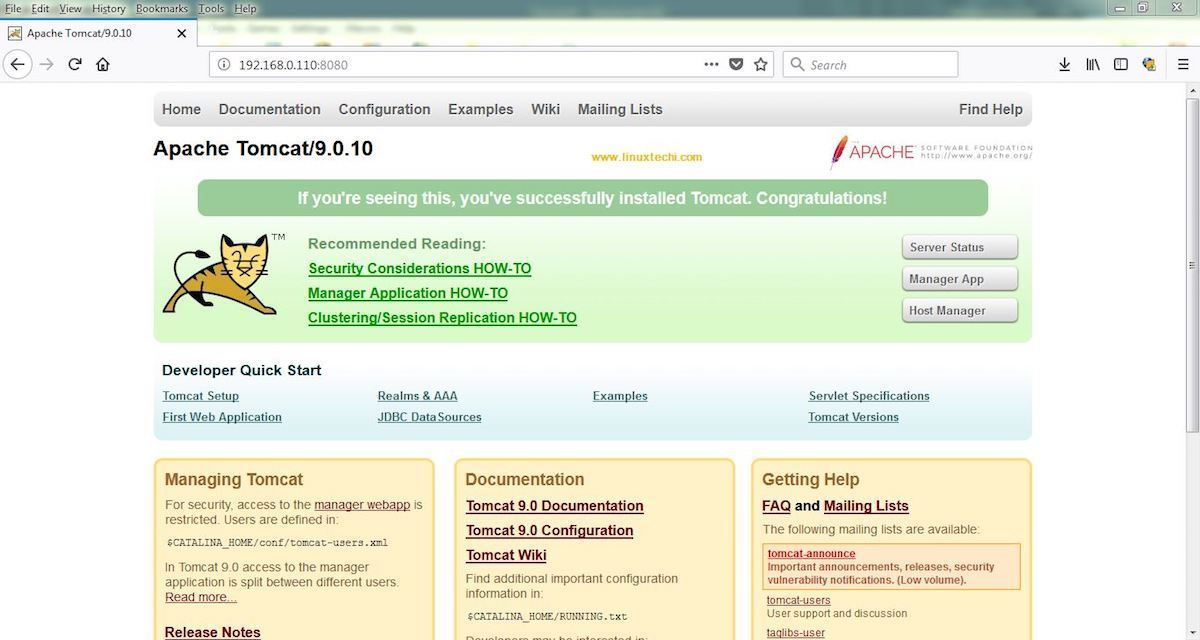
Apache Tomcat is a prolonged-lived, open up source Java servlet container that implements a number of main Java company specs, specifically the Java Servlet, JavaServer Pages (JSP), and WebSockets APIs.
An Apache Program Basis job, Tomcat was very first introduced in 1998, just 4 a long time immediately after Java by itself. Tomcat started off as a reference implementation for the first Java Servlet API and the JSP spec. While it truly is no for a longer period the reference implementation for possibly of these technologies, Tomcat stays the most broadly made use of Java server, boasting a properly-examined and demonstrated main engine with excellent extensibility.
In this small introduction, you are going to discover why several computer software retailers select Tomcat for working Java internet applications. You can expect to get an overview of Tomcat and how it is really utilized, as very well as installation guidance for the most latest model as of this composing.
What sort of server is Tomcat?
The Java ecosystem supports numerous forms of application server, so let us disambiguate them and see wherever Tomcat suits in:
- A servlet container is an implementation of the Java Servlet specification, utilised largely for internet hosting Java servlets.
- A world-wide-web server is a server built to serve information from the nearby process, like Apache.
- A Java company software server is a full-blown implementation of the Java EE (now Jakarta EE) specification.
At heart, Tomcat is a servlet and JSP container. A Java servlet encapsulates code and business enterprise logic and defines how requests and responses really should be handled in a Java server. JSP is a server-facet perspective rendering technological know-how. As the developer, you create the servlet or JSP site, then permit Tomcat tackle the routing.
Tomcat also consists of the Coyote engine, which is a internet server. Thanks to Coyote, it is feasible to extend Tomcat to include a wide range of Java company specs and abilities, like the Java Persistence API (JPA). Tomcat also has an extended version, termed TomEE, that involves extra company attributes. I am going to briefly introduce TomEE afterwards in this article.
Let us start out with a glimpse at employing Tomcat to host servlets and JSPs.
Down load and install Tomcat
Getting a hoary historical of the software earth, a variety of Tomcat versions are out there. Facts on model differences is out there on the Tomcat homepage. You can normally just select the most current stable version.
For our needs, download the most up-to-date edition of Tomcat, which at the moment is Tomcat 9. You have a preference of downloading Tomcat as an archive (.zip or tar.gz), or as an set up support. The best choice is up to you–unless of course of course you are not jogging on Windows, in which situation you will go for the archive. We will use the archive for this write-up.
Move 1. Command-line installation
Go to the command-line and form gunzip apache-tomcat-9..19.tar.gz adopted by tar -xf apache-tomcat-9..19.tar. This makes the adhering to directories:
- /bin incorporates the scripts for executing Tomcat.
- /webapps is the site where you will deploy your applications.
- /logs is exactly where Tomcat outputs its logs. Be aware that Tomcat’s logs go into
/logs/catalina.outby default. You can use this file to debug troubles in conjunction with application-particular log information. - /lib is in which Tomcat appears to be for JARs. This is exactly where you can expect to retailer extra offers not involved with Tomcat, this sort of as JPA.
- /conf is the config XML for Tomcat, wherever you can do matters like incorporating buyers and roles for Tomcat.
Phase 2. Start Tomcat
If you mounted Tomcat as a support, it is now functioning. Or else, go forward and get started it up by entering ./catalina.sh commence at the command line. (Sort ./catalina.sh with no arguments to see all of the obtainable instructions). Now, you should be in a position to browse to Tomcat’s welcome display in a browser.
 Matthew Tyson
Matthew TysonDeploying programs in Tomcat
Tomcat’s webapps listing is exactly where you deploy an software. You can fall a .war file there and Tomcat will operate it. A WAR file is the standard packaging for a internet software useful resource: a JAR file with some extra information telling the container (in this circumstance Tomcat) how to run it.
Apart from the typical packaging, there are three supplemental ways to deploy written content in Tomcat.
Exploded deploy
An “exploded” web application is an application that is not compressed into a WAR file, which means it nonetheless has all the components laid out in directories and documents. The Tomcat archive you unpacked delivered with several examples deployed in this manner, which you are going to obtain in the /webapps/illustrations directory. The advantage of an exploded deploy is you can look at the information there devoid of worrying about compression.
If you navigate to http://localhost:8080/illustrations/, you may locate a checklist of hyperlinks. This webpage is rendered by Tomcat from the /webapps/examples/index.html file. Tomcat is serving an HTML file from the file method, which is an instance of Tomcat’s Coyote engine performing as a world wide web server.
You are absolutely free to explore the illustrations offered–they give you a great overview of Tomcat’s capabilities for serving servlets, JSPs, and WebSockets.
Tomcat also features a management application by default, uncovered less than the /manager route. Amongst other items, this application makes it possible for you to begin, prevent, and redeploy apps from a website console.
Serving static content material
It truly is feasible to provide data files from the file technique, or ahead from Tomcat to another HTTP server like Apache. Yet another widespread set up is to place a file server like Apache or Nginx in front of Tomcat, and then forward your API requests into Tomcat. In these scenarios, the mod_JK library is made use of to configure Tomcat and Apache (or even another web server like IIS) to talk.
For enhanced performance, generally in offering static material, Tomcat also gives native wrappers for Windows and Linux. This is acknowledged as Tomcat APR and a lot more info is offered below. These are not important for regular use circumstances, but very good to know about.
Embedded Tomcat
For a lengthy time, Jetty was the only server capable of jogging as an embedded server. That has transformed, and now Tomcat can also operate embedded. The notion in applying an embedded server is that rather of the server made up of the software files, as you’ve got found so significantly, you have an software with a most important course (that is, a standalone Java application), that invokes the server capabilities from inside of its code foundation. General, this delivers a much more basic and portable enhancement design, and has promptly turn out to be the norm. Spring Boot, for example, takes advantage of an embedded Tomcat occasion jogging in dev method.
Working an embedded server can internet simplicity in phrases of functions, because you are now dealing with just a one component (the app) as an alternative of working with both of those the application and a server deployment. On the other hand, the set up exactly where Tomcat operates as an impartial host is nevertheless really prevalent.
TomEE
It is possible to use a lot more of the common Java EE (or Jakarta EE) capabilities with Tomcat by adding those people libraries to Tomcat by itself, or to your application dependencies. One more choice is the TomEE server. TomEE is the very same Tomcat motor with more Java enterprise assist, together with the well-liked JPA and CDI (Contexts and Dependency Injection) APIs. TomEE’s spec is based mostly on the Java EE web profile, so it provides you extra than Tomcat but isn’t a complete-blown Java EE application server like WildFly or Glassfish.
Summary
Tomcat stays actively formulated, keeping rate with change, and offering a good and trustworthy platform for deploying internet applications. The two its ongoing acceptance and preference as the default Java system for numerous PaaS devices testify to its ongoing accomplishment.







